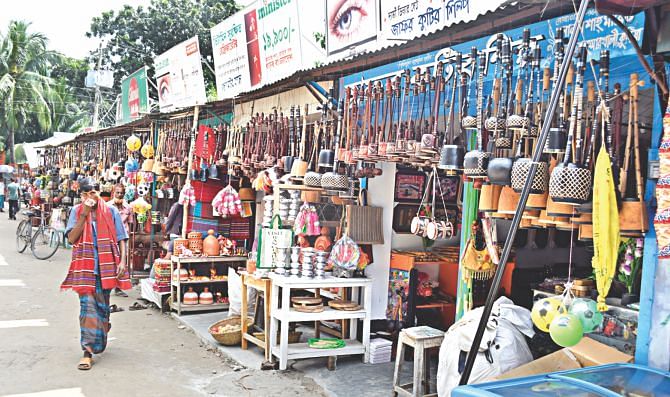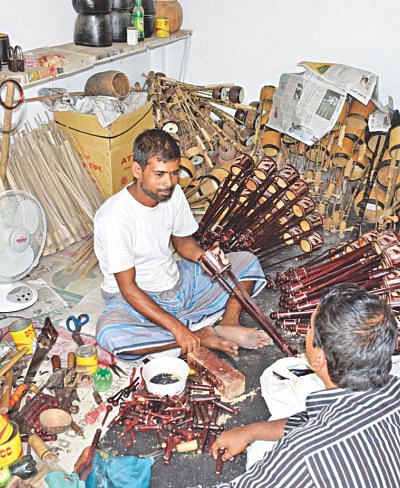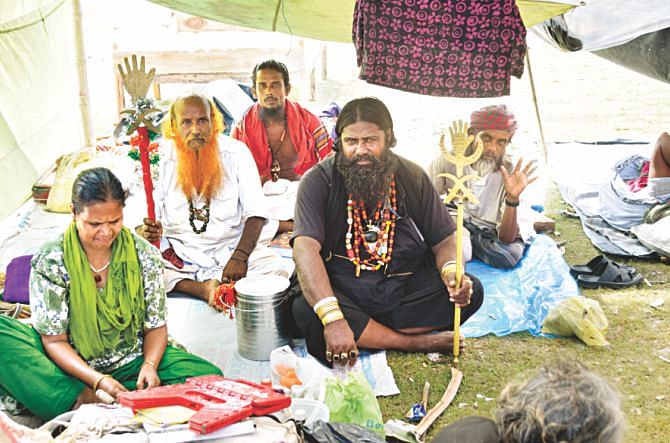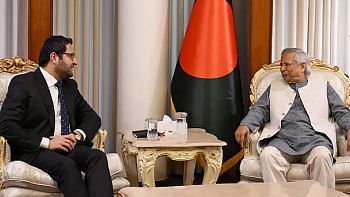Five-day Lalon festival begins today

Traditional Baul musical instrument makers in Kushtia and adjacent districts of Meherpur, Chuadanga and Jhenidah have their hands full, meeting orders ahead of the five-day memorial festival marking the 124th death anniversary of Baul Lalon Shah.
The festival begins today and will run till October 20.
The Baul musical tradition incorporates a number of musical instruments that are in great demand at such festivals. The instruments include ektara, dotara, dhol, mandira, banshi, khol, khamak and dung.
Of these instruments, Bauls frequently use the ektara (a one-stringed instrument) and dotara, which is a multi stringed (usually 4 stringed) lute instrument, used for accompaniments.
Other percussion instruments include the baya or khol drum, and small cymbals called kartal and manjira. The dugi is a small handheld earthen drum.
An Akhra bari market with some 50 shops for the sale of such instruments has been set up in front of the main gate of Lalon's shrine.
Azhar, has been in the business for 25 years. He has set up a small factory where he produces four varieties of instruments. This is among 35 such small factories in several villages surrounding the Lalon shrine.
The instrument-makers are reaping in good returns this year--a jump from previous years.
Although bauls never believed in any prescribed musical form of instruments, inclusion of various instruments were the need and demands of times. These gradually have taken a place in Baul traditions, and through practice and persuasion of the divine songs and incorporation of newer instruments, the tradition is just not alive but is flourishing.
Historical records suggest that the ektara was the only musical instruments used inside the akhra from the times of Lalon, and that tradition continues even today.

Other percussion instruments include the baya or khol drum, and small cymbals called kartal and manjira. The dugi is a small handheld earthen drum.
Initially, it was the bamboo flute, the ektara and dotara that were used, but then progressively rhythm instruments such as mandira, kartal, jhuri, and later drums such as dhol, khol and naal made their steady entry into the baul trend.
It was in fact about two decades after the transition of Lalon that the baya or small drum slung to the waist and played with the left hand was included into this form of folk music.
According to instrument-makers, this is one of the two peak times of two festivals in the year to produce and sell the items that they look forward to.
“We make all of the instruments in our factory and supply these to the Akhra market and to different parts of the country as per the demand of buyers,” said Azhar Uddin alias Pillad Mistri of Cheuria village, the village where the Lalon shrine is located.
Azhar, also a baul philosophy lover, has been in the business for last 25 years. He established a small factory where he produces 4 types of instruments, he said.
“Business this year is good and we are happy with the number of orders,” said Kanu Sarder of Char Milpara, who runs a small instrument-making factory.
Prices of these items are also reasonable. Wood, bamboo, wire is needed to make the musical instruments.
Buyers from different parts of the country come to the shrine during the occasion, and collect such musical instruments, some makers said.
An ektara can cost from Tk. 50 to Tk.1000, while a dotara goes for 150 to 1500 and a khol at 2,500-2,700.
Although bauls never believed in any prescribed musical form of instruments, inclusion of various instruments were the need and demands of times. These gradually have taken a place in the heart of baul traditions, and through practice and persuasion of the divine songs and incorporation of newer instruments, the tradition is just not alive but is flourishing.
Bauls assemble in huge numbers
Amanur Aman, Kushtia
The mystic songs of Baul king Fakir Lalon Shah reverberate at his den on the occasion of a five-day memorial festival dedicated to the bard at Cheuria in Kushtia.
The festival, also known as Dol Purnima, will start this evening.
The festival is one of the largest annual congregations of Bauls and devotees of Lalon at his den where around 1.5 lakh Bauls, shai and other devotees from within and outside the country are present.

Professor Dr. Gowher Rizvi, International Affairs Advisor of Prime Minister Sheikh Hasina, is likely to inaugurate the event.
Kushtia Deputy Commissioner (DC), Syed Bealal Hossain will preside over the programme.
Lalon Academy that oversees the Lalon shrine has organised the programmes.
Among others, Professor Abdul Hakim Sarkar, vice-chancellor of Islamic University (IU) and Professor Dr. Shaheenor Rahman, pro-VC of IU, will speak at the programmes.
The shrine has been decorated beautifully for the festival.
One of the main attractions of the event is a Baul Mela (fair).
The festival is held annually, highlighting the philosophy of Lalon. The celebration was introduced by Lalon Shah, the great mystic singer, himself. After his demise, the festival turned into a tradition.
During the festivals, Bauls pay homage to their spiritual leader and render impassioned Lalon songs.
Baul Lalon, king of the Bauls is known as a classical Bengali poet and philosopher who raised some universal questions in the simplest of ways.
According to experts, he composed around 2,000 verses which were then articulated through songs and philosophical thought.

 For all latest news, follow The Daily Star's Google News channel.
For all latest news, follow The Daily Star's Google News channel. 



Comments